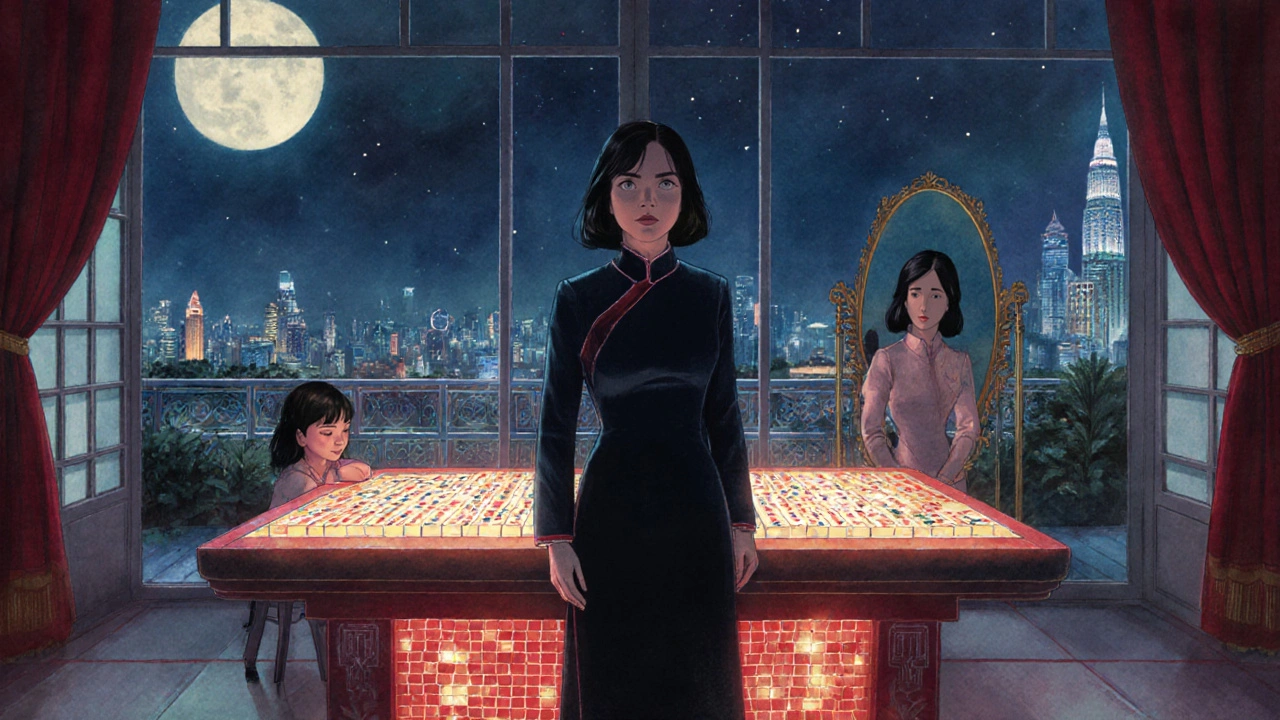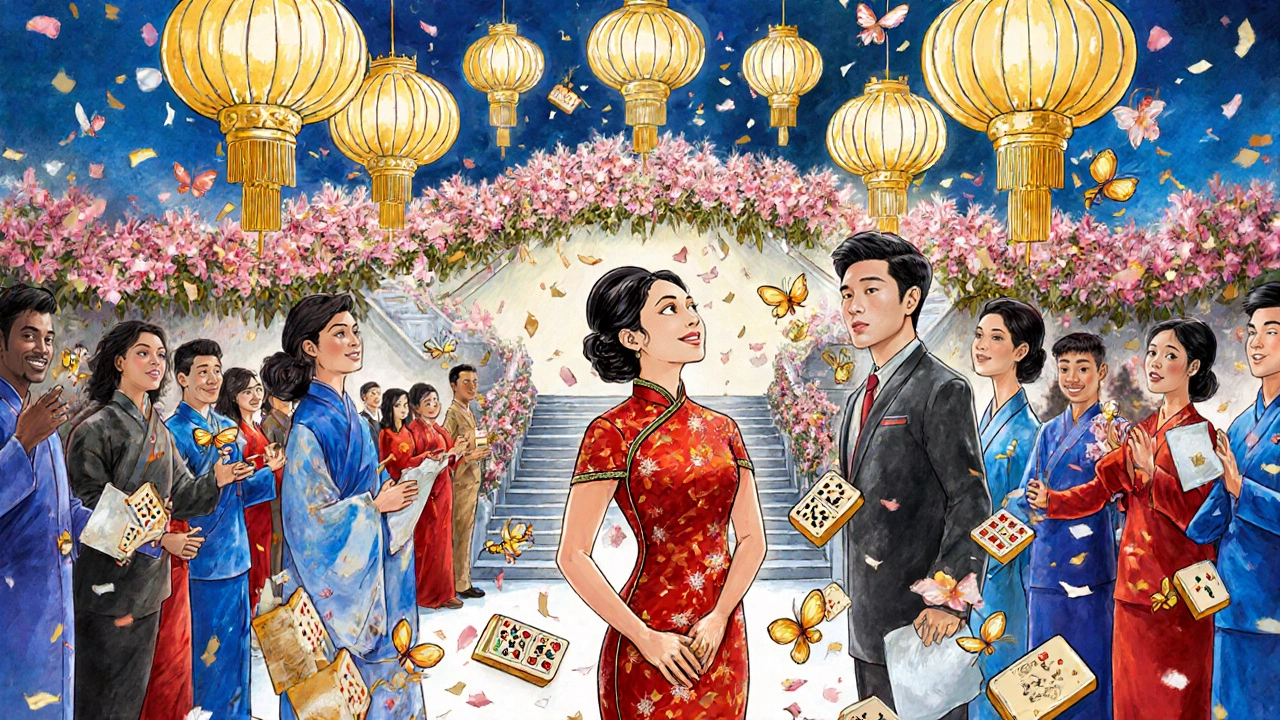Crazy Rich Asians didn’t just make money-it broke a 25-year silence in Hollywood. Before 2018, no major studio had released a romantic comedy with an all-Asian cast since The Joy Luck Club in 1993. When this film hit theaters, it wasn’t just another love story. It was a cultural reset. For Asian-American audiences, seeing themselves on screen-not as sidekicks, villains, or stereotypes-but as complex, desirable, wealthy, and deeply human characters, felt like a long-overdue mirror. And it wasn’t just emotional. It was financial. The $30 million budget returned over $413 million globally. Studios took notice.
More Than a Love Story
At its core, Crazy Rich Asians follows Rachel Chu, a pragmatic NYU economics professor played by Constance Wu, as she travels to Singapore to meet her boyfriend Nick Young’s family. What she finds isn’t just romance-it’s a world of private jets, marble bathrooms, and mahjong games where fortunes are赌 on porcelain tiles. Nick’s mother, Eleanor, portrayed by Michelle Yeoh, sees Rachel as a threat to family legacy. Their clash isn’t just about class-it’s about identity. Rachel is Chinese-American, raised in Queens. Eleanor is Singaporean, raised in tradition. Their tension isn’t manufactured for drama; it’s rooted in real cultural divides.What made this film different from other rom-coms? It didn’t make ethnicity the punchline. There were no exaggerated accents, no clumsy misunderstandings based on “Asian quirks.” The humor came from situations anyone could relate to: awkward in-laws, jealous exes, the pressure to impress someone’s family. But it was all framed through an Asian lens. The wedding scene wasn’t just lavish-it was a celebration of Chinese, Malay, and Peranakan traditions. The mahjong scene didn’t just show a game-it showed how power, gossip, and loyalty move through generations.
The Visual Language of Wealth
Director Jon M. Chu didn’t shoot this like a typical Hollywood film. He treated Singapore like a character. The camera lingered on silk robes, gold jewelry, and rooftop gardens that looked like something out of a dream. The color grading was bold-blues, reds, and golds saturated every frame. It wasn’t just about showing off. It was about reclaiming the narrative. For decades, Asian wealth in film was either invisible or portrayed as sinister. Think of The Hangover Part II, where Bangkok was a backdrop for white characters’ chaos. Here, Asian wealth was beautiful, powerful, and human.The soundtrack was equally intentional. Western pop songs like Madonna’s “Material Girl” were reimagined in Mandarin, sung by a chorus of women during a high-stakes mahjong game. It wasn’t a gimmick. It was a statement: We own this culture. We can remix it. We can be both modern and traditional at the same time.
Breaking the Stereotype Mold
One of the most talked-about moments in the film wasn’t a line of dialogue-it was a look. When Nick Young walks into a party shirtless, water droplets glistening on his chest, the camera doesn’t cut away. It lingers. For decades, Asian men in Hollywood were portrayed as nerds, villains, or asexual figures. Think of Long Duk Dong in Sixteen Candles or the perpetually awkward sidekicks in 90s teen movies. Crazy Rich Asians flipped that. Henry Golding’s Nick was handsome, confident, emotionally open, and desired. He wasn’t the sidekick-he was the romantic lead. Roger Ebert called it “a quiet revolution.”Michelle Yeoh’s Eleanor was just as groundbreaking. She wasn’t the dragon lady or the submissive matriarch. She was complex. Protective. Cold, yes-but her cruelty came from love, fear, and generational trauma. She wasn’t evil. She was a woman who had sacrificed everything to protect her family’s name. That nuance was rare.

Box Office Proof That Representation Sells
The numbers don’t lie. Crazy Rich Asians opened at number eight in its first weekend. By week two, it was number one-beating The Meg. It stayed in the top ten for seven weeks. In China alone, it made $64 million. That’s not just a win for diversity-it’s a win for business.Before this film, studios claimed Asian-led stories were “too niche.” They said audiences wouldn’t connect. But the data showed otherwise. According to Warner Bros.’ internal reports, the film’s return on investment was 482%. The average rom-com ROI? Around 300%. The film didn’t just appeal to Asian audiences-it drew in white, Black, and Latino viewers too. A SurveyMonkey poll found 63% of all respondents, regardless of race, acknowledged its cultural significance.
The Ripple Effect
The impact didn’t stop at the box office. Within 18 months of its release, Warner Bros. greenlit at least three other Asian-led projects. SAG-AFTRA reported a 22% increase in speaking roles for Asian actors between 2017 and 2019. Streaming platforms saw a 37% jump in Asian-led content views in late 2018. Nielsen called it “the Crazy Rich Asians effect.”It paved the way for Shang-Chi and the Legend of the Ten Rings in 2021, which grossed $433 million. It gave space for Everything Everywhere All At Once in 2022 to win Best Picture. And it proved that audiences don’t just want representation-they want excellence. The film didn’t win Oscars, but it won something bigger: permission.

Criticism and Complexity
It wasn’t perfect. Some critics called it a “luxury advertisement.” The focus on designer bags, yachts, and private islands made it easy to dismiss as shallow. Reddit users called it “a two-hour Gucci commercial.” Others pointed out that it reinforced the “model minority” myth-suggesting all Asians are wealthy, successful, and assimilated.Dr. David Yoo of UCLA warned that the film’s portrayal of extreme wealth could mislead people into thinking Asian success is universal. But that’s a misunderstanding. The film didn’t claim to represent all Asians. It represented one family-one slice of a vast, diverse diaspora. It didn’t need to be a universal truth to be meaningful.
Another critique came from those who felt it lacked emotional depth. Compared to The Farewell, which explored grief and silence in a quiet, intimate way, Crazy Rich Asians was loud, glittering, and fast-paced. But that wasn’t its goal. It wasn’t trying to be a tearjerker. It was trying to be seen.
What It Meant for Asian Audiences
For many, watching this film wasn’t entertainment-it was validation. One Reddit user wrote: “I cried in the theater because I’d never seen my culture portrayed without shame.” Another said, “I finally felt like I belonged in a movie.” These weren’t rare comments. They were everywhere.Asian-American teens started posting TikToks recreating the mahjong scene. Parents took their kids to see it. Grandparents, who had never seen themselves in a Hollywood film, clapped at the end. It became a generational moment.
Where We Are Now
Five years later, the landscape has changed-but not enough. Asian actors now hold 7.2% of lead roles in major studio films, up from 1.4% in 2017. But behind the camera, only 23% of Asian characters in 2023 films were written by Asian writers. The industry still struggles with who gets to tell these stories.Warner Bros. announced development of the sequel, China Rich Girlfriend, in January 2023. Jon M. Chu is producing. The original cast is expected to return. But the bigger question isn’t whether the sequel will happen-it’s whether Hollywood will keep building on this foundation.
Crazy Rich Asians didn’t solve racism in Hollywood. But it proved one thing: stories about Asian people can be global blockbusters. They can be funny, romantic, dazzling, and deeply human. And audiences will show up-if you give them a reason to.
Is Crazy Rich Asians based on a true story?
No, Crazy Rich Asians is not based on a true story. It’s adapted from Kevin Kwan’s 2013 bestselling novel of the same name, which blends fiction with real cultural details from Singapore’s elite society. While the characters and events are fictional, the setting, social dynamics, and traditions depicted are grounded in the lived experiences of wealthy Asian families in Southeast Asia.
Why was Crazy Rich Asians so important for Asian representation?
Before Crazy Rich Asians, Hollywood hadn’t released a major studio film with an all-Asian principal cast in 25 years. It shattered the myth that Asian-led stories couldn’t succeed commercially. It gave Asian audiences a rare chance to see themselves as the romantic leads, the powerful matriarchs, and the glamorous elite-not as sidekicks, villains, or stereotypes. The film’s success proved diversity isn’t a risk-it’s a market opportunity.
Did Crazy Rich Asians win any Oscars?
No, Crazy Rich Asians didn’t win any Oscars. It received no major nominations, despite its box office success and cultural impact. This omission sparked widespread criticism, with many pointing out the Academy’s continued blind spots in recognizing films with diverse casts. However, its legacy lies in changing industry standards, not awards.
How much did Crazy Rich Asians make at the box office?
Crazy Rich Asians grossed $174.5 million domestically and $238.5 million internationally, for a worldwide total of $413 million. Made on a $30 million budget, it delivered a 482% return on investment-far exceeding the average rom-com ROI of 300%. It was the highest-grossing romantic comedy of 2018.
Is there a sequel to Crazy Rich Asians?
Yes, Warner Bros. officially announced development of a sequel based on Kevin Kwan’s second novel, China Rich Girlfriend, in January 2023. Jon M. Chu is attached as a producer, and while no release date has been set, the original cast is expected to return. The project was delayed by the pandemic but remains active as of 2025.
Why do some people criticize Crazy Rich Asians?
Critics argue the film glorifies extreme wealth and reinforces the “model minority” myth by suggesting all Asian families are affluent. Some felt it focused too much on luxury brands and missed deeper social issues. Others compared it unfavorably to The Farewell, which they felt had more emotional depth. But supporters counter that the film never claimed to represent all Asian experiences-it simply gave visibility to one perspective that had been ignored for decades.
What impact did Crazy Rich Asians have on Hollywood?
The film’s success led to a 22% increase in speaking roles for Asian actors in major studio films between 2017 and 2019. It influenced studios to greenlight more Asian-led projects, including Shang-Chi and Everything Everywhere All At Once. Streaming platforms saw a 37% spike in Asian content views after its release. Industry analysts credit it with proving that diverse stories can be box office hits, shifting long-held assumptions in Hollywood.

